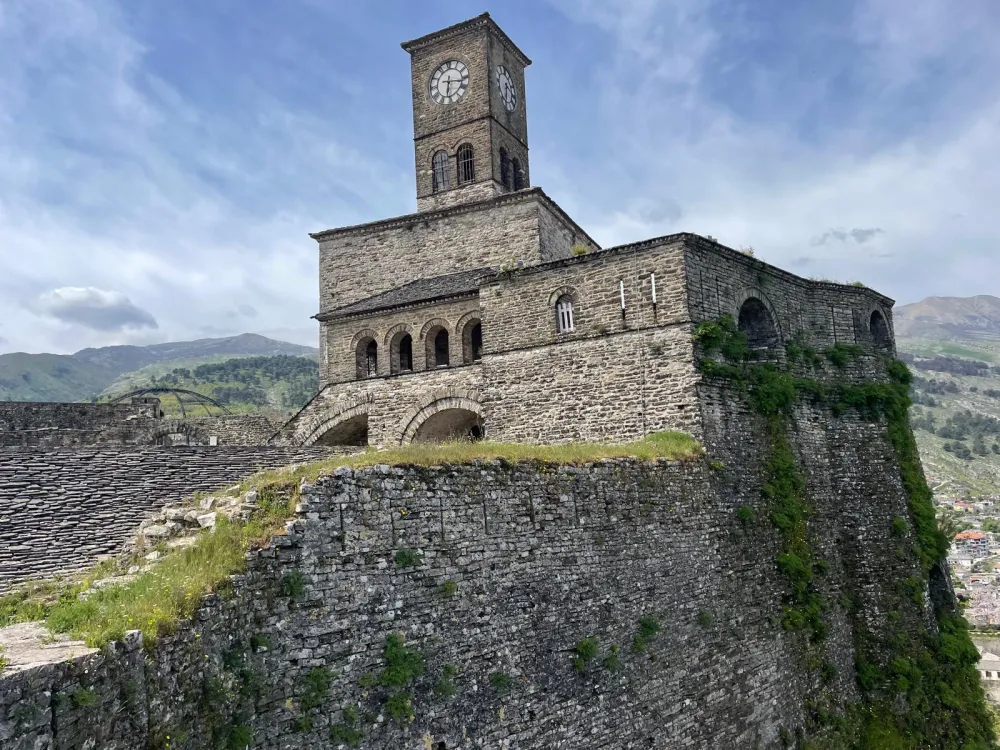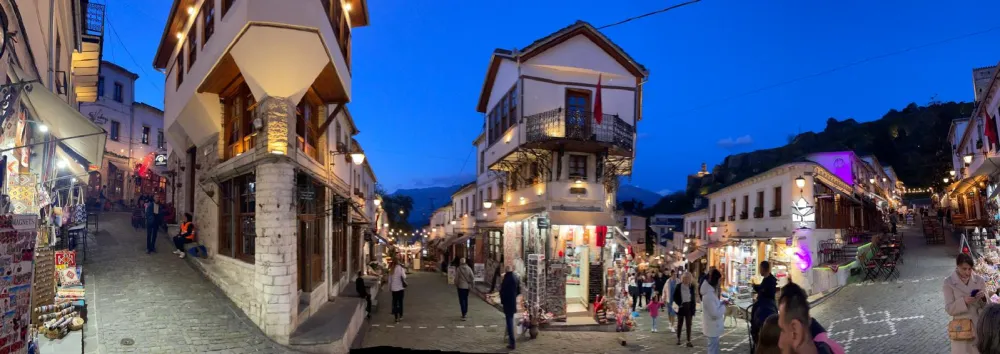Gjirokastër guide 
A historic city in southern Albania, known as the "Stone City" for its unique Ottoman houses with slate roofs. The city is dominated by a vast citadel, picturesque streets and an ancient bazaar, which create a unique atmosphere of bygone times.
Sights and attractions - What should you visit in Gjirokastër? The local castle, the Old Bazaar or perhaps the Cold War Tunnel?
Accommodation - Where to stay in Gjirokastër? Recommendations for accommodation in the city center and beyond in the pleasant peace of the vineyards.
Practical tips - How to get to Gjirokastër? What to watch out for? Where to go on trips around the area?
Typical food and drink - What should you try in Gjirokastër - the local specialty qifqi, the lamb roast Janina or perhaps the local soda Glina.
Celebrities - Which famous personalities lived and created in Gjirokastër?
Weather - What temperatures and precipitation should you prepare for in Gjirokastër?

Gjirokastër, nicknamed the “city of stone”, is one of the most charming and authentic cities in Albania. It lies in a valley between the Gjerë Mountains and the Drino River in the south of the country, and its historic center has been a UNESCO World Heritage Site since 2005. The city is famous for its unique Ottoman architecture – typical stone houses with sloping slate roofs, narrow cobblestone streets and an ancient bazaar, where it still lives today.
Gjirokastër is dominated by a large fortress that towers over the city and offers not only panoramic views of the surrounding landscape, but also exhibitions dedicated to the history of the region. Gjirokastër was also the birthplace of several important figures – such as the writer Ismail Kadar or the former communist leader Enver Hoxha.

The city and its surroundings will be enjoyed not only by history and culture fans, but also by nature lovers. Nearby you will find ancient monuments such as the city of Antigonea or the Roman Hadrianopolis. The surrounding mountains and valleys offer opportunities for hiking, photography and exploring the Albanian nature. You can also enjoy traditional Albanian cuisine in the unique atmosphere of the ancient city.
Gjirokastër is an ideal destination for a day trip from Saranda or the Albanian Riviera.
Sights and monuments
Gjirokastër Castle (Kalaja e Gjirokastrës) - The largest landmark of the city, originally from the 12th century, later expanded by the Ottoman rulers. Inside you will find a military museum, a city museum and an exhibition of weapons. The castle offers panoramic views of the city and the Drino Valley.
Address: Access from the city center, entrance from the Old Bazaar.

Çerçiz Topulli Square - The main square of the old town, named after the national hero. It serves as a starting point for sightseeing in the surrounding monuments and is a popular place for local social events.
Address: Sheshi Çerçiz Topulli, Gjirokastër.
Old Bazaar (Pazari i Vjetër) - The oldest quarter of the city, a center of traditional trade, cafes and restaurants. It is home to Ottoman houses with slate roofs and a mosque from 1757 (Xhamia e Pazarit), which is the only surviving mosque in the city of the original thirteen.
Address: Qafa e Pazarit (Sedlo), historic center.

Skenduli House (Shtëpia e Skëndulit) - An exceptionally well-preserved house from the Ottoman period, built in the early 18th century. It offers an authentic look at the life of wealthy families in the past. Tours are often led by a member of the original family. The entrance fee is 200 lek and you can visit the house during the high season from April to October.
Address: Rruga Sokaku i te Mareve, Gjirokastër.
Zekate House (Shtëpia e Zekatëve) - One of the most beautiful and best preserved traditional houses in Gjirokastër, built in 1811-1812. It stands out for its defensive features, richly decorated interior and magnificent views of the city.
Address: Rruga Bashkim Kokona, Gjirokastër.

Ethnographic Museum (Gjirokastra Ethnographic Museum) - The museum is located in a house built on the site of Enver Hoxha's birthplace. The exhibition presents the traditional lifestyle, crafts and culture of the region in the authentic setting of an Ottoman house.
Address: Palorto, Gjirokastër.
Ismail Kadare House (Ismail Kadare House) - The birthplace of the world-famous writer Ismail Kadare, today a museum with an exhibition dedicated to his life and work.
Address: Rruga Fato Berberi 16, Palorto, Gjirokastër.
Cold War Tunnel - A vast underground bunker built in the 1970s by the communist regime under the leadership of Enver Hoxha. The tunnel was intended as a refuge for local party and government elites in the event of a nuclear attack or other crisis. The entire complex measures 800 meters and contains 59 rooms, including offices, a decontamination room, a generator room, bedrooms, a kitchen and water storage. The tunnel remained a secret for many years, even from ordinary city residents, and was only made accessible to the public in 2014.
Address: Sheshi Çerçiz Topulli, Gjirokastër, behind the city hall.

Accommodation
Although Gjirokastër has only around 20,000 permanent residents, you can choose from a huge number of accommodation capacities. Apartments are the most popular, followed by guesthouses, hotels, private houses and villas, and there are also cheap hostels. A few accommodations have a swimming pool, while air conditioning can be used almost everywhere.
Probably the most luxurious accommodation in the city center is the 5* N'SOKAK Boutique Hotel. Guests can use free private parking, a terrace and a bar. They can then relax in the garden or in the jacuzzi. Considering that this is a 5* hotel, you will be surprised by the pleasant prices.
If you prefer to stay in silence close to nature, check out the 4* The Barrels Ms hotel. It is located about 4 km from the center of Gjirokastër among vineyards. You can stay here in one of the rooms with a view of the city. Guests have free private parking, a restaurant, a garden and a terrace. In the morning, you will be woken up by the singing of birds.
Those who like historical buildings will definitely not be disappointed if they stay at the Old Bazaar 1790 hotel. The house from 1790 originally served a large wealthy family. The communists then divided it into several apartments and after the fall of communism it was privatized and rebuilt into a hotel. The building is located in the heart of the old town, and you can enjoy mountain views from the rooms. The 24-hour reception offers concierge service and luggage storage. There is also a terrace and a bar.

For cheap accommodation in the city centre, try Stone City Hostel. You can stay in either a private or shared room. Guests can use the shared kitchen, lounge, garden, terrace or bar. Tourist information is available at the reception. You can also store your luggage here.
For a complete offer of accommodation in Gjirokastër, we recommend using A-HOTEL.com. You can also use Booking.com.
Practical travel tips
Buses from Tirana to Gjirokastër run six times a day from the southern bus terminal. The journey takes approximately 4 hours. Direct bus connections also run from Berat, Përmet, Korçë and Saranda.
During the tourist season, buy bus tickets in advance, especially on the Gjirokastër–Sarandë route, and beware of dishonest intermediaries.
There is a public transport system in the city that will take you from the bus station to Çerçiz Topulli Square in the historic center. Private buses are prohibited from entering the old town.
If you are traveling by car, you can park on the edge of the historic center, access to the old town is limited.
If you are traveling by car, watch out for sheep on the roads. ;)

In the Old Town, narrow stone streets lead up steep hills and down again. So wear comfortable shoes and be prepared to sweat a little. After the rain, beware of slippery stones.
There are many local guides in the city who offer themed tours and cooking classes for traditional specialties.
It can be very hot in the summer, but in the underground attractions (e.g. the Cold War Tunnel) the temperature is only around 15°C, so don't forget to bring some extra clothes.

👍 Our tip: In the city area, you can take trips to the Blue Eye spring (Syri i Kaltër), to the Zagoria Valley (off-road trips), or rafting on the Vjosa River near Përmet.
Typical food and drink
Qifqi - One of the most famous dishes straight from Gjirokastër - small balls made of boiled rice, eggs and fresh herbs (especially mint), which are fried in a pan. Qifqi can be found on the menu of most local restaurants.
Janina (roast lamb) - Another traditional dish, often prepared with herbs, baked in the oven. Locals prepare it especially during festive occasions.
Byrek - A savory pie made of thin filo dough, filled with spinach, cheese, meat or vegetables. Byrek is common throughout Albania, but in Gjirokastër you can also find local variations.
Stuffed Vegetables (Patëllxhanë/Speca/Domate te mbushur) - Eggplants, peppers or tomatoes stuffed with a mixture of rice, meat or gjizë cheese, often seasoned with herbs. Baked in the oven.
Moussaka - In Gjirokastër, both the traditional moussaka with eggplant, tomatoes and minced meat, as well as the local potato variant with pork and egg, are prepared.

Tarator - A refreshing cold soup made of yogurt, cucumbers, garlic, dill and walnuts, ideal during hot summer days.
Shapkat - A typical pie made of corn flour, spinach and cheese. This is a regional specialty of southern Albania.
Baklava, halva, revani - Sweet desserts of oriental origin, often with honey, nuts and syrup, common in Albanian cuisine.
Raki - Traditional Albanian brandy, most often made from grapes or plums. Served as an aperitif or digestif.
Glina - A popular local mineral soda, which comes from a spring in the Gjirokastër region.
Famous people
Enver Hoxha (1908–1985) - Albanian communist leader, dictator and long-time ruler of Albania. He declared the country the first atheist state in the world and built many anti-nuclear bunkers during his rule. He was born in Gjirokastër.
Ismail Kadare (1936–2024) - World-renowned Albanian writer, poet and essayist, whose works were strongly inspired by his hometown of Gjirokastër.
Çerçiz Topulli (1880–1915) – National hero and symbol of Albanian resistance against the Ottoman Empire. The main square in Gjirokastër is named after him.
Eqrem Çabej (1908–1980) – A prominent linguist, historian and founder of Albanian linguistics, after whom the local university is named.
Omer Nishani (1887–1954) – Politician, President of Albania after World War II. His brother taught Enver Hoxha in Gjirokastër.

Weather
Gjirokastër has a Mediterranean climate with hot, dry summers and cold, wet winters.
During the hot and dry summer, temperatures often exceed 35°C. In July and August, only around 10 mm of rain falls.
In autumn, temperatures gradually decrease, September is still warm (on average around 22°C), in November only around 12°C. Precipitation increases sharply in autumn, with the heaviest rainfall in November, around 400 mm.
A long, cold and very humid winter will welcome you with temperatures around 5–6°C, and at night it can even be below zero. It rains often, even over 200 mm per month, and it is often cloudy.
It gradually warms up in spring, and in May the average temperatures reach around 18°C. Precipitation decreases towards summer.
In total, Gjirokastër receives around 1870 mm of precipitation per year, which is a lot by Albanian standards. It rains the most from October to March, and the least in the summer months.